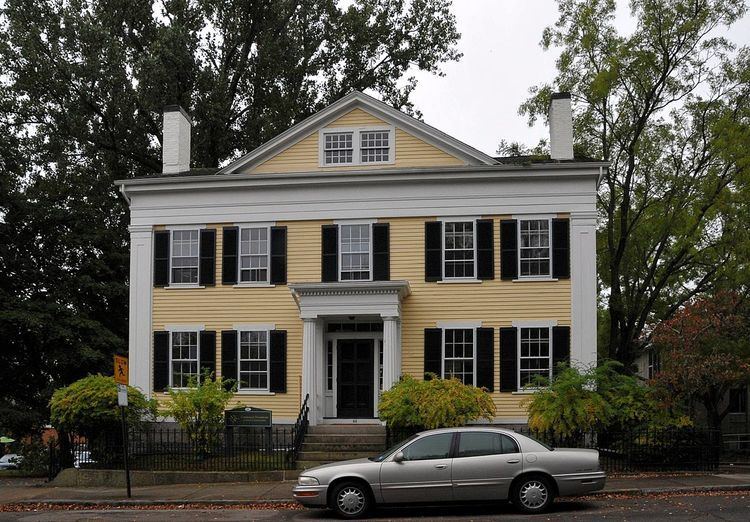Built 1837 Opened 1837 Added to NRHP 22 April 1976 | NRHP Reference # 76001992 Area 4,000 m² | |
 | ||
Similar Ye Antientist Burial Gr, Lyman Allyn Art Museum, New London Harbor Li, New London Customhouse, United States Coast Gu | ||
The Acors Barns House is located in New London, Connecticut. Built in 1837, the Acors Barns House is a two-and-one half story Greek Revival house with a gable roof and clapboarded exterior. The front facade of the house is five bays wide with a Greek Revival portico leading to the main entrance. Additions to the house include a projecting center dormer, and second-story projection over a partially enclosed veranda. The plain exterior is contrasted by interior's elaborate hall ceilings, detailed woodwork and arched marble fireplaces.
Contents
In 1862, Barns died and the house was passed to his sons before being transferred to Harriet Barns Vincent. The house was sold to Julia O'Sullivan in 1919 before being sold to Francis McGuire in 1956. The McGuire's operated the house as a law firm and passed the title to James McGuire. In 2013, James McGuire sold the house to the Community Foundation of Eastern Connecticut. Dave Collins wrote that the Acors Barns house is a "fine and rare example" of architecture that is especially important to New London, Connecticut. The Acors Barns House was added to the National Register of Historic Places on April 22, 1976.
Acors Barns
Born in 1794, Acors Barns was the son a mariner and lived in Westerly, Rhode Island before moving to Stonington, Connecticut. Barns moved to New London, Connecticut and formed a whaling company with William Williams Jr. in 1827. The company prospered and became one of the largest firms in the city, but Barns avoided the 1849 decline of the whaling industry by investing elsewhere. Barns invested in the Willimantic and Palmer Railroad before establishing the Bank of Commerce in 1852. Barns died in 1862, but his sons would continue the successful Bank of Commerce.
Design
Built in 1837, the Acors Barns House is a two-and-one half story Greek Revival house with a gable roof and clapboarded exterior. The front facade of the house is five bays wide with 6-over-6 sash and the main entrance has a Greek Revival portico supported by fluted Doric columns from top step. The simple single-panel door is surrounded by sidelights. The corners of the building have simple pilasters and four chimneys rising from the top. The rear of the house has a one-story veranda with a shallow hipped roof that is supported by square columns with a simple balustrade. The veranda has large 6-over-9 sash windows that extend almost a full story. In 1975, the area surrounding the property has undergone significant change, but the house is surrounded by trees and shrubs and a wrought iron fence that helps set it apart from the neighborhood.
Modifications to the house include the addition of a large pediment-shaped dormer that projects from the center of the main roof and is lighted by a rectangular double window. Part of the veranda was enclosed and the stairs that lead to a formal garden were removed. Above the center of the veranda is a second-story projection that was described as visually compromising the elegance of the rear facade.
The plain exterior is contrasted by the elegance of the interior of the house. The house has elaborate hall ceilings, detailed woodwork and arched marble fireplaces. The floor plan is built around the central hall with an offset stairway. The parlor rooms to the right are separated by a wide archway. The two rooms to the left are a dining room and a pantry that has a dumbwaiter to the kitchen in the cellar. The National Historic Register of Places nomination noted that the cellar contained the "remains of the kitchen, washroom and wine cellar". The second floor is made of four chambers and the attic consists of five small rooms. The attic's rooms served as the servants' cubicles.
Owners
The Acors Barns House has gone through several owners over its lifetime. In 1862, the house passed from Acors Barns to his son William H. Barns. In 1893, the second son, Charles Barns acquired the title to the house and transferred it upon his death to Harriet Barns Vincent, the daughter of his sister. Harriet Barns Vincent sold the house to Julia O'Sullivan in 1919. Francis McGuire purchased the house in 1956 and it would later pass to James McGuire. In 2013, James McGuire sold the house to the Community Foundation of Eastern Connecticut for $325,000. The foundation stated it would continue to preserve the house's historical integrity.
Importance
Clouette writes, "The Barns house physically documents the symbiosis by which the wealthy and the propertyless shared a home. Its value as an artifact is enhanced by the successful reuse which has retained the character of the building." Dave Collins of the The Day wrote, "The Barns house is also especially important to New London because it is such a fine and rare example of the architectural fabric of the big swath of the downtown that was demolished in urban renewal in the 1960s."
